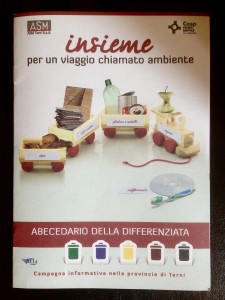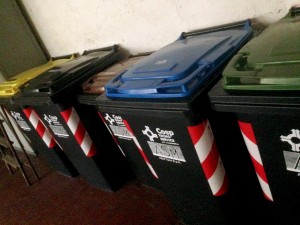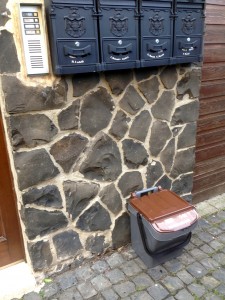This is a subject I’ve been wanting to approach since I began this blog, but I resist, telling myself that it isn’t that interesting or that I don’t know enough about it. Okay, outsider eyes find it very interesting, and it’s about what I do know, not everything there is to know. Therefore…
I’m going to talk trash.
 Last May, the nation-wide transition had already begun. Instead of trundling your recyclables to the ugly, dirty, domed containers that squatted in parking lots, you put a sack of a specific type of trash at your street door and a guy in a small hopper-truck came around the next morning and picked it up. My stay was short and I didn’t generate much trash, so details escaped me, but I knew it was a new sun dawning on the refuse horizon.
Last May, the nation-wide transition had already begun. Instead of trundling your recyclables to the ugly, dirty, domed containers that squatted in parking lots, you put a sack of a specific type of trash at your street door and a guy in a small hopper-truck came around the next morning and picked it up. My stay was short and I didn’t generate much trash, so details escaped me, but I knew it was a new sun dawning on the refuse horizon.
When I returned in October, either the system had been expanded and refined, or I had become a more active producer of garbage (many friends would suggest I started down that path years ago) for the system was more nuanced than I remembered. Every night, Sunday through Friday, we put a sack of something specific to the left of the front gate. Organic was three times a week (in bio-degradable and compostable bags,) glass and plastic once, paper once, and undifferentiated (that which cannot yet be recycled) once. You had to keep in mind what went out when, and that took getting used to, but it was a tidy system.
Then shortly after the first of this year, a small, brownish, perforated plastic box appeared next to my front door. At first, I  speculated a late Christmas present (“late” was an American interpretation; it was before Epiphany and therefore would have been perfectly legal) but as I continued to the ground floor, I noticed that everyone had received these boxes. When I returned home, I took mine inside to investigate.
speculated a late Christmas present (“late” was an American interpretation; it was before Epiphany and therefore would have been perfectly legal) but as I continued to the ground floor, I noticed that everyone had received these boxes. When I returned home, I took mine inside to investigate.
Included in the box was a year’s supply of compostable plastic bags and three colorful brochures detailing the intricacies of trash separation. A calendar for “Orvieto Nord” specifies what picks up on which days, when holiday service kicks in and what that means, and shows a schedule for domestic trash on one side and commercial on the other. There was a two-fold summarizing what goes into each genre of pick up and how to “prepare” it for the guy with the truck. There was a booklet indexing every conceivable throw-away and exactly what you’re allowed to do with it. The box itself was for personal collection of organics.
 Because we are a palazzo with six apartments, we were given five, specifically sized and designed, color-coded and clearly labeled bins for the sorting of our refuse. The categories now are organic (in compostable bags,) plastic and metal (which is a clever combo, because we can include things like pharmaceutical blister packs,) glass, undifferentiated, and paper and cardboard. The bins live downstairs in the garage, and we wheel them out on the appropriate night as someone in the building remembers to do so.
Because we are a palazzo with six apartments, we were given five, specifically sized and designed, color-coded and clearly labeled bins for the sorting of our refuse. The categories now are organic (in compostable bags,) plastic and metal (which is a clever combo, because we can include things like pharmaceutical blister packs,) glass, undifferentiated, and paper and cardboard. The bins live downstairs in the garage, and we wheel them out on the appropriate night as someone in the building remembers to do so.
For smaller buildings, each household was given a set of little color-coded bins that go out on the same schedule. Walk around in the evening, and the streets are dotted with these spunky creatures. While they don’t fit the medieval/renaissance townscape, they are a lot less unsightly than old collection domes. Some of us find them rather cute.
Since all this occurred, my curiosity about disposability in general has increased. So, I checked the plastic bags I receive through the week, and 90% of them are compostable. I asked at the market what to do with juice containers. The guy referred me to the label, most of which now have instructions on proper disposal according to category. This is much more specific than “please recycle.” It means “put this in the right bin or risk fines.”
I’m sure there are valid questions about what is done with all this meticulously collected trash. Are the contractors engaged to process it doing the job, or will the stuff be dumped into a swamp somewhere? How is Italy’s tenacious history of kick-back and bribery affecting all this? Is the elaborate and beautifully designed collection process merely the latest example of an Italian genius for elaborate and beautiful design, that once put into place will suffer from neglect and gradually grow ineffective?
Those are questions too great for this outsider, and the answers can only be known in time. What Italy is doing looks like a solid beginning, and one worth emulating in other places; especially by those entities who take pride in organizational skill and procedural elegance, but whose environmental programs are soaked with politics.
Besides, we’re past the point of having other options. Either we stop pretending that “disposable” means we can throw it away without further thought, or we stop producing stuff we call disposable that isn’t. Or a mix of both. (I find it curious, and disturbing, that my spellcheck doesn’t even recognize the word, indisposable. If it’s not a word, I now invent it.)
Think about the environmental crisis for a moment. Eventually, all solutions boil down to careful use of resources and intelligent disposal of waste. A well-considered effort to address issues of disposal, even if it may have its flaws, is leagues ahead of a half-hearted one where the central tenets are to be affordable to business and convenient for the consumer.
We’ve kicked the trash can down the road for a couple of generations now, it’s time to grow up. At the very least, Italy (and the EU) are taking steps.